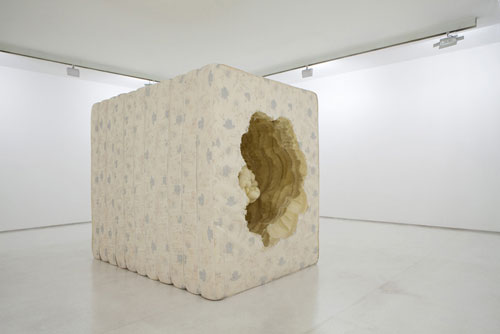ENRIQUE – VALLOIS
T.+33(0)1 46 34 61 07
HENRIQUE OLIVEIRA Fissure
Through these tensions, Oliveira, undoubtedly makes visible the illusion that Nature is taking back its right. Triumphant, it destroys urbanity. Concrete yields and cracks up under the implacable evidence of its strength. Within this visible dynamics probably lies an underground dialectics where nature and culture meet, discuss and argue, through the prism, among others, of the organic and the built, of the animated and the inanimated. Oliveira still forces a certain idea of nature into an institutional universe. An abundant lattice which can just as much blend with what it comes across.
In his installation Baitogogo at the Palais de Tokyo, which displays a successful transplant with the building, Oliveira mingles exposed girders and imaginary tree trunks. A frontal collusion point to be read in-between nature and culture, but not as a sermon on an earth wounded by the presence of man. The artist rather seems to inscribe himself within a formal research on how man lays its hand on the world that surrounds him. Tapumes wood, fine wood slivers used for construction site fences in Brazil, could perhaps remind us how human beings model – sometimes clumsily – their territory and inhabit this earth they are the depository of.
It can happen that the «urban epidermis», words of the artist, grows in an anarchic manner. And cities implode under the weight. His three dimensional works or drawings on paper, made up of protuberances and growths, are perhaps an implicit portrait of the demographic context in which he grew up.
Poor materials also show how much Oliveira is mesmerised by construction and the elaboration of space. It is not surprising that the artist visited New Orleans after Hurricane Katrina. Everything in these devastated and worn out landscapes had to be rebuilt. A world to be created, a location where life had to be injected again. Therefore Henrique Oliveira went to gather mattresses, pillows, vestiges of a quiet domestic life, to pile them up in a deformed magma, of an explicit poverty. Condensation shows torn mattresses, as if eaten away by emptiness. Years after being pulled out of the slump, they still display open wounds, like residual and historical gaps.
Scraps objects , natural elements, deprivation of materials… his creations maintain a close relation with Arte Povera. Although the artist himself admits that the poor wood is close to the theoretical statement made by this movement, the use of recovered materials is more a way to force the boundaries of contemporary sculpture
and its relationship to space.
Henrique Oliveira invents oneiric forms infiltrated with life, in the same way a demiurge would bring to life, from the real and ex nihilo, a universe with fantasised contours.
Léa Chauvel-Lévy
